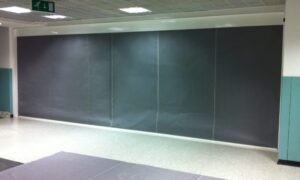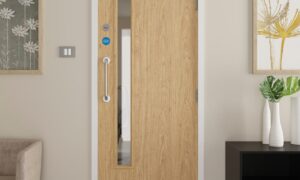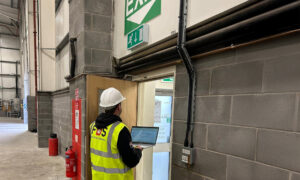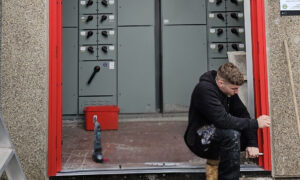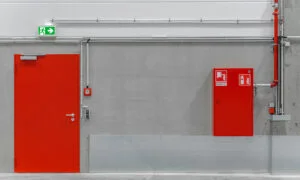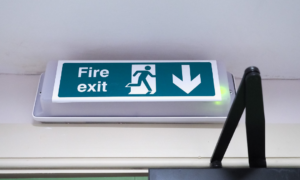When it comes to fire safety, a standard door won’t cut it. Fire doors are specifically designed and tested to hold back fire and smoke for a set amount of time — anywhere from 30 minutes to a couple of hours. But what makes these doors so different from normal doors?
Here, we look at what fire doors are made of, why the materials matter and how to choose the right type of fire door for your business.
What is a fire door made of?
A fire door is usually made from timber, steel or glass. It’s often heavier and thicker than a standard door and reinforced with specialist materials that help it resist heat, flames and smoke.
Importantly, the construction of a fire door is tested by an independent third-party organisation and given an FD-rating. These ratings indicate the amount of time a door can act as a barrier against heat, fire and smoke:
- FD30: resists fire for 30 minutes
- FD60: resists fire for 60 minutes
- FD90: resists fire for 90 minutes
- FD120: resists fire for 2 hours
- FD240: resists fire for 4 hours
- FD360: resists fire for 6 hours
The higher the FD rating, the thicker and more robust a fire door will be.
Common fire door materials
Fire resistant doors can be made from different materials, depending on where they’re used and the FD-rating required. Here are some of the most common fire door materials.
Wood
Timber fire doors are a popular choice for internal fire doors in offices, schools, hospitals and residential buildings. They combine aesthetic appeal and fire safety.
So how are these fire doors made? Most wooden fire doors have a solid, fire-resistant core. This can be made from specialist chipboard, multi-layered wood or solid wood. The core is then surrounded by timber framing.
Beyond the practicalities, timber fire doors can be constructed with various aesthetic finishes. You can get wooden fire doors with panels, as a “book-matching” pair (where the wood grain on double fire doors is mirrored) or with glazed sections.
Steel
Steel fire doors are constructed from galvanised steel sheets around a fire-resistant insulated core. Steel doors are often given a powder coat finish for aesthetic appeal and to offer protection against the elements.
These doors are tough and durable, and they offer excellent security. They’re a popular choice for industrial buildings — like factories and warehouses — and for external exits.
Glass
Glazed panels are common in both timber and steel fire-rated doors. But some doors can be made almost entirely from fire-rated glass.
Ceramic glass (including borosilicate glass) or laminated glass are often used. These types of glass remain intact and form a fire-resistant barrier under fire conditions. Sometimes, wire mesh glass is used. This prevents glass from shattering as temperatures rise.
Glass fire doors help to maintain visibility along escape routes. They also allow natural light into corridors and stairwells.
Fire door construction: more essential components
A fire door isn’t just the door leaf itself. For a fire door to work properly, you need a couple of other essential components. Together, the door and its components (known as a door set) work to prevent the spread of smoke and fire.
A fire door set includes the following.
Intumescent seals
Intumescent seals are installed around the edges of a fire door — they expand in heat to block flames and smoke.
Hinges and handles
All door hardware — including hinges and handles — has to be tested and certified for fire performance. This hardware is made from a robust material, like stainless steel.
Locks
If a fire door locks, this locking mechanism also has to be fire-rated. Locks are sometimes fitted with intumescent lock protection. The intumescent material expands to fill gaps around the lock and latch under high temperatures.
Automatic door closers
For fire doors to work properly, they need to be kept closed at all times. A fire-rated door closer ensures that your door closes back into the frame each time it’s opened.
Electromagnetic door holders
In cases where a fire door has to be held open to ensure the easy movement of people or equipment, another door component is necessary. An electromagnetic door holder keeps the door open but is wired to a fire alarm system. When the alarm goes off, the door is released automatically.
Fire resistant sealant
When a fire door is installed, any gaps between the wall and the door frame have to be filled properly, with fire resistant material.
For a door to perform according to its FD-rating, all components need to be certified to the same rating. For example, if your door is rated to FD60, fire door components have to be rated to FD60, too.
Which fire door materials offer the best fire protection?
Timber, glass and steel fire doors are available with ratings ranging from FD30 to FD120. However, for high-risk environments, it has to be steel. Steel fire doors are available with ratings up to FD360 — that’s six hours of fire protection.
Choosing the right fire doors for your business
Fire doors aren’t just thicker doors. They’re engineered systems built from tested materials like fire-resistant timber, steel and glass. Along with seals, frames and door hardware, these materials work to prevent the spread of fire and smoke, and give people time to escape the building.
When choosing between these fire door materials, the most important consideration is compliance. Your doors — and every part of the door set — have to meet the correct FD rating to keep your people safe.
At Fire Door Systems, we design, manufacture, install and maintain fire doors for commercial, industrial and public buildings up and down the UK. As fire safety experts, we can also offer advice on the fire door construction that will help you meet fire safety regulations.
Want to chat about your fire door requirements? Contact the FDS team today.

